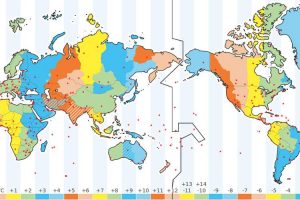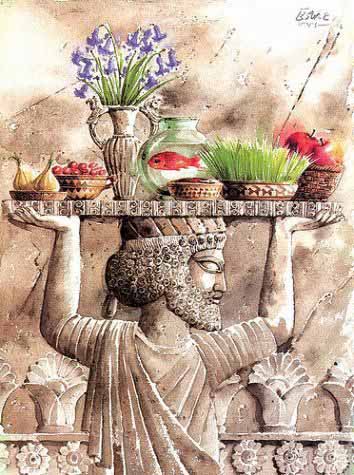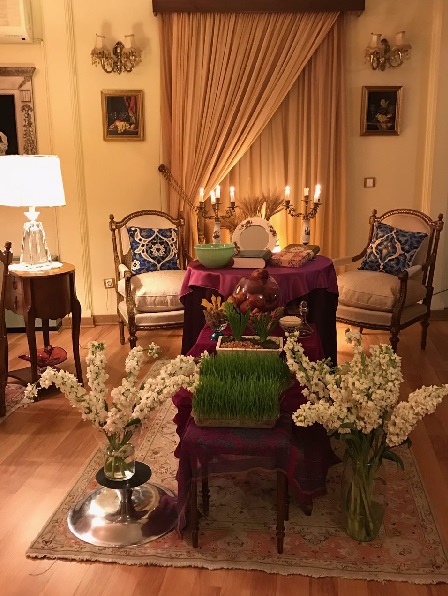 Iranian New Year of 1396 Has Just Started at the World’s East Point : Monday 20th of March 2017 has just started at the Eastern part of the world; Where and When the “IDL” (International Date Line) time starts from an imaginary time line at about 180 degrees east (or west) of the Greenwich Meridian. (see below map):
Iranian New Year of 1396 Has Just Started at the World’s East Point : Monday 20th of March 2017 has just started at the Eastern part of the world; Where and When the “IDL” (International Date Line) time starts from an imaginary time line at about 180 degrees east (or west) of the Greenwich Meridian. (see below map):

Apart from all these imaginary assumptions for different geographical and computerized control of time, the most correct and accountable system has been the Iranian “Solar Calendar” which has been invented by the Iranian astronomers. According to this calendar, each full and exact year is calculated by a system which is called the “Tropical Year” which is exactly 31536000 seconds or 8765.812536 hours.
Of course, in common years the year has 31536000 seconds and in a “Leap” year it has 31622400 seconds. (To know more and have the calculation, if you are interested please click “Either Here” or “Here“.
Based on these calculations, both years of 2016 (in Georgian Calendar) and 1395 (in Iranian Calendar) are the “Leap Years” and so we have one extra day for this year (2016 or 1395). In this regard, today (Monday March 20th 2016) at the GMT time of 10:28:40 (13:58:40 in Iran) the new year of the Iranian starts and the countries like Afghanistan and Tajikistan which have the same solar system for their calendar, start their new year.
What is called “Nowruz“?

Nowruz is the traditional Iranian festival of spring which starts at the exact moment of the vernal equinox, commencing the start of the spring. It is considered as the start of the New Year among Iranians. The name comes from Avestan meaning “new day/daylight”. Noruz is celebrated March 20/21 each year, at the time the sun enters Aries and Spring begins.
Noruz has been celebrated for at least 3,000 years and is deeply rooted in the rituals and traditions of the Zoroastrian religion. Today the festival of Noruz is celebrated in Iran, Iraq, India, Afghanistan, Tajikestan, Uzbekistan, Azerbaijan, Kazakhstan, and Kyrgyzstan.
The Zoroastrian Parsis of India celebrate Noruz twice, firstly in common with their Iranian brethren on the vernal equinox as Jamshedi Navroz (also referred to as the Fasli New Year) and secondly on a day in July or August, depending upon whether they follow the Kadmi or the Shahenshahi calendar. This is because the practice of intercalation in the Zoroastrian calendar was lost on their arrival in India. The Kadmi New Year always precedes the Shahenshahi New Year by 30 days. In 2005, Noruz is celebrated on August 20 (Shahenshahi).
The Baha’i Faith, a religion with its origin in Iran, celebrates this day (spelling it “Naw Ruz”) as a religious holiday marking not only the new year according to the Baha’i calendar, but the end of their Nineteen Day Fast. Persian Baha’is still observe many Iranian customs associated with it, but Bahai’s all over the world celebrate it as a festive day, according to local custom. American Baha’i communities, for example, may have a potluck dinner, along with prayers and readings from Baha’i scripture. While Naw Ruz, according to scripture, begins on the vernal equinox, Baha’is currently celebrate it on March 21, regardless of what day the equinox falls. Baha’is are required to suspend work and school in observance.
Although the Persian Calendar is very precise about the very moment of turn of the new year, Noruz itself is by definition the very first calendar day of the year, regardless of when the natural turn of the year happens. For instance, in some years, the actual natural moment of turn of the year could happen before the midnight of the first calendar day, but the calendar still starts at 00:00 hours for 24 hours, and those 24 hours constitute the Noruz. Iranians typically observe the exact moment of the turn of the year.
To read more about this special new year’s festive in Iran please “Click Here”
**********************
Now, at the beginning of the Iranian new year of 1396, we wish all the best for all of our readers throughout the world, and promise to have great changes at our portal to make it more fruitful for the readers and the occasional viewers of PIMI.IR.












